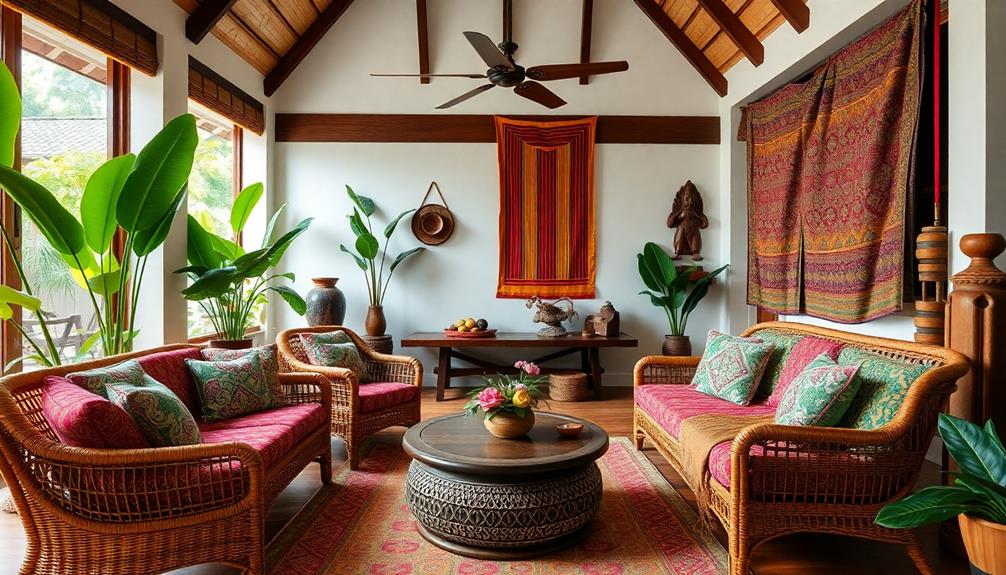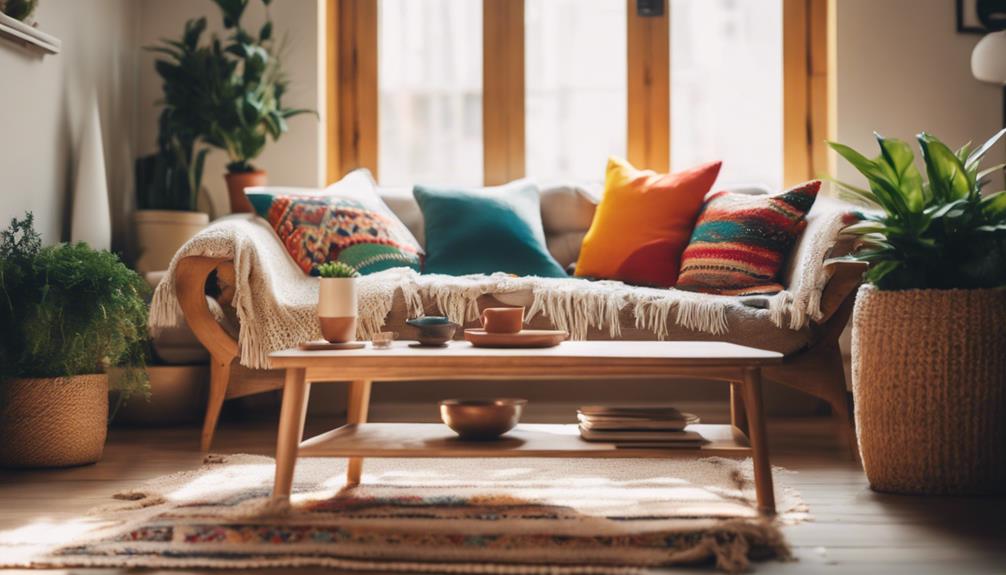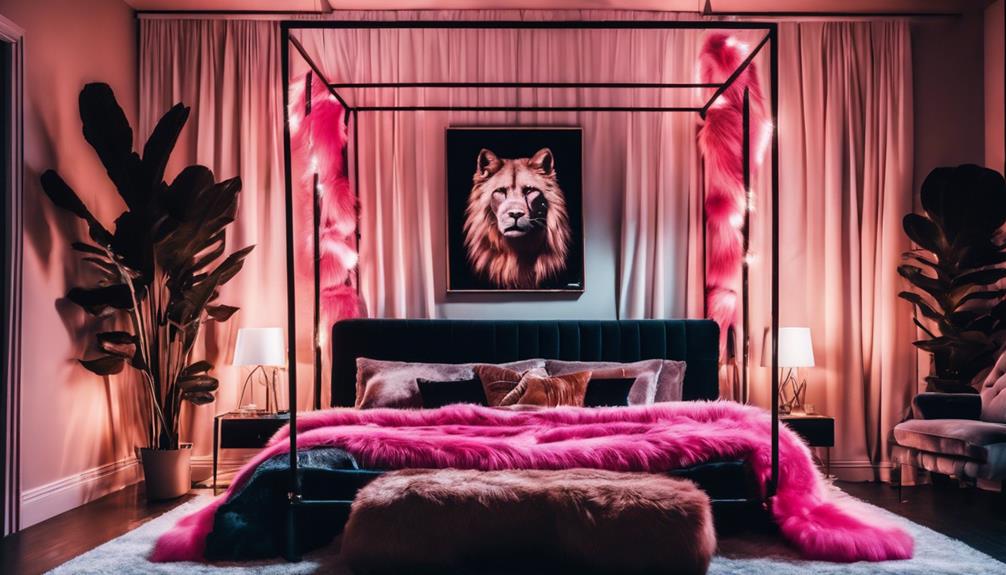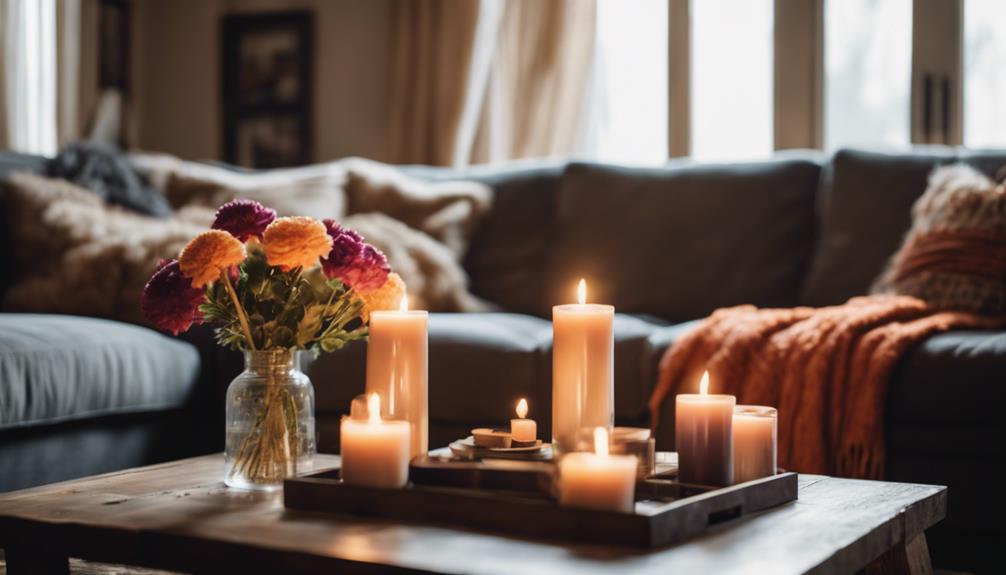Indonesian patterns, especially batik, have a rich history that dates back over 2000 years. Originating in Java, batik's intricate designs, created through wax resist dyeing, reflect local beliefs and nature. Each pattern carries stories of strength and identity, making them significant in home decor. As you explore these vibrant textiles, you'll notice how artisans blend tradition with contemporary styles, adding warmth and character to modern spaces. From Central Java's detailed works to Bali's colorful creations, each region offers unique expressions. There's so much more to discover about how these patterns continue to evolve and inspire!
Key Takeaways
- Indonesian patterns, particularly batik, have roots in ancient textile traditions dating back over 2000 years in Java.
- Batik uses wax resist dyeing to create intricate designs, with both hand-drawn and stamped techniques.
- The vibrant colors and motifs in batik textiles reflect local beliefs, nature, and cultural narratives.
- Regional variations of batik influence home decor, with each region offering unique patterns and styles.
- Contemporary design integrates traditional batik, enhancing home decor with cultural richness and personal expression.
Origins of Indonesian Patterns
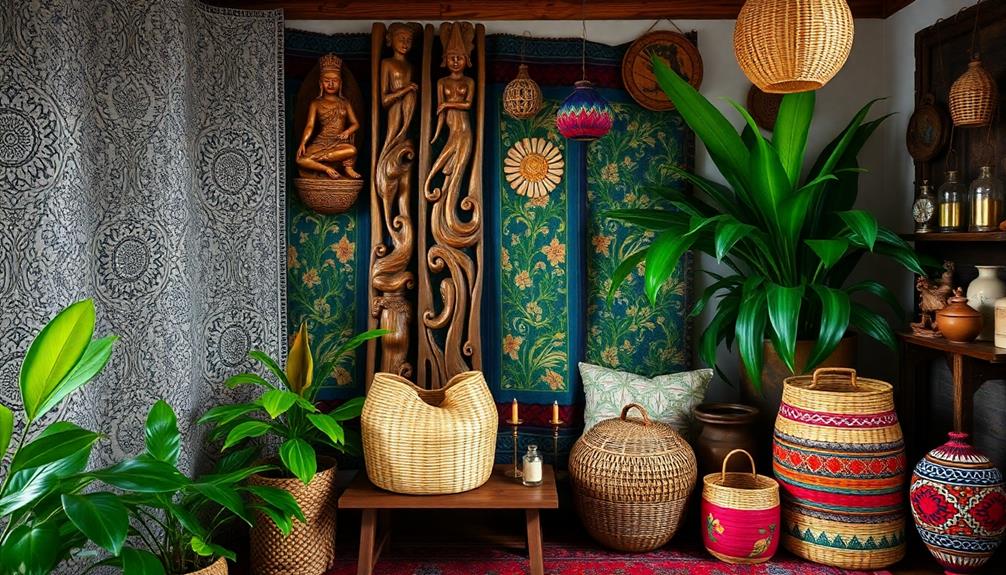
Indonesian patterns' rich history is rooted in ancient textile traditions, particularly the art of batik, which has thrived for over 2000 years in Java. The term "batik" comes from the Javanese word "ambatik," meaning cloth with little dots, reflecting the intricate designs that characterize Indonesian textiles.
These traditional patterns often draw from local beliefs, nature, and cultural events, with each motif carrying significant symbolic meanings, such as fertility and prosperity. The vibrant artistry of these patterns also finds expression in traditional artistry, showcasing the skill of local artisans who create unique designs that tell stories of their heritage.
As you explore Indonesian home decor, you'll notice how batik integrates seamlessly into various items, transforming curtains and tablecloths into beautiful expressions of cultural heritage.
The vibrant colors found in Balinese batik reveal Hindu cultural influences, while the intricate designs of Central Java showcase meticulous craftsmanship. These regional variations enhance the aesthetic appeal of your space, offering a glimpse into the diverse cultural influences that have shaped Indonesian patterns.
Techniques of Pattern Production
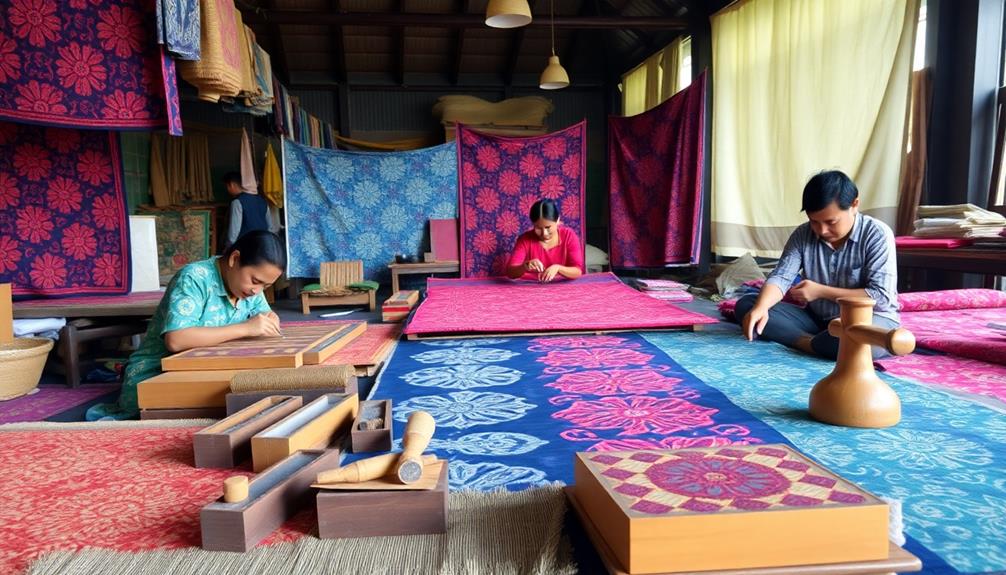
The intricate world of batik production showcases a blend of artistry and technique that captivates both creators and admirers. This traditional Indonesian textile art employs a wax resist dyeing method that creates stunning patterns and intricate designs on fabric. You'll find the process begins with applying hot wax using a canting tool. This allows artisans to draw fine lines and shapes before submerging the fabric in vibrant dye baths.
Here's a brief comparison of the two main batik techniques:
| Technique | Description |
|---|---|
| Batik Tulis | Hand-drawn, labor-intensive, detailed motifs |
| Batik Cap | Stamped, quicker production of patterns |
Motifs such as Parang and Kawung often symbolize strength and prosperity, adding depth to the designs. Once the dyeing is complete, artisans remove the wax through boiling or ironing, revealing the vibrant patterns characteristic of batik fabric. These beautiful pieces make for stunning home decor, showcasing the rich heritage of Indonesian textile art. Whether you choose Batik Tulis or Batik Cap, each piece tells a story through its unique patterns and colors.
Cultural Significance in Decor
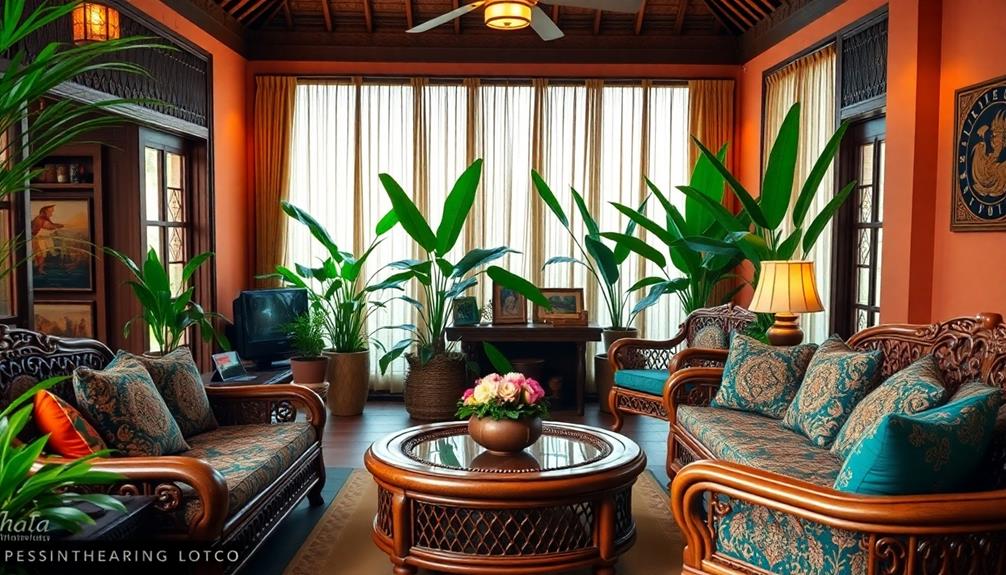
Cultural patterns in home decor often tell stories that resonate deeply within communities. Batik textiles, celebrated as an intangible cultural heritage, embody the art of batik, reflecting local beliefs and the beauty of nature.
Incorporating elements like Indonesian decor masks into your design can further enhance the cultural richness of your space. When you incorporate these traditional patterns into your interior design, you not only beautify your space but also connect with cultural narratives that have been passed down through generations.
The vibrant colors and intricate motifs of batik enhance the aesthetic appeal of your living areas. Items like curtains, tablecloths, and pillow covers showcase this artistry, allowing you to express your Indonesian identity.
Regional variations, such as those from Central Java or Bali, introduce diverse decor styles that let you personalize your home while honoring your heritage.
Contemporary Applications in Design
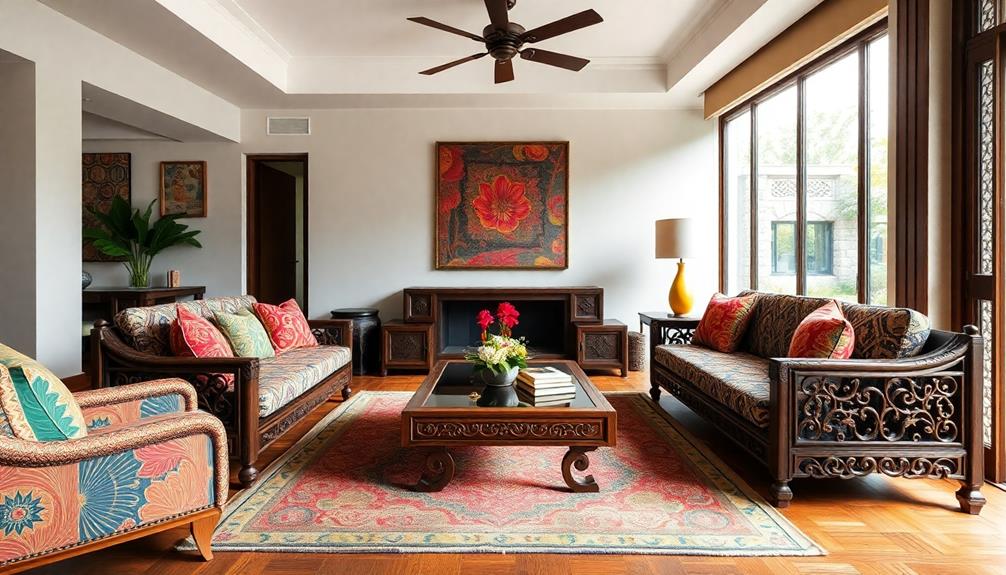
Incorporating traditional patterns into modern design creates a unique blend that resonates with today's aesthetic sensibilities. You'll find that batik fabric, with its intricate patterns and vibrant colors, is increasingly popular in home decor. Designers use it to craft unique statement pieces like curtains, tablecloths, and cushion covers that enhance contemporary interiors while honoring cultural heritage.
Artisans collaborate with designers to innovate batik patterns, merging traditional motifs with modern aesthetics. This fusion not only preserves Indonesian craftsmanship but also caters to current interior design trends. Batik items add warmth and character, making them ideal for accent walls and decorative panels.
Here's a quick overview of how batik is applied in contemporary design:
| Application | Description |
|---|---|
| Home Decor | Functional items that showcase cultural heritage |
| Unique Statement | Bold pieces that stand out in any space |
| Contemporary Interiors | Harmonizing traditional and modern elements |
Regional Variations and Influences
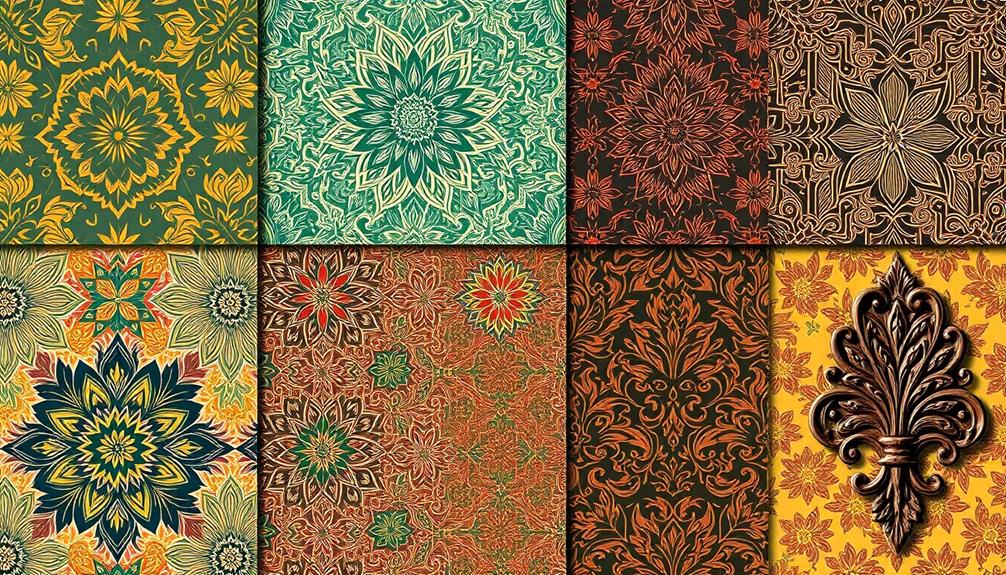
Indonesia's diverse regions showcase a stunning array of home decor patterns that reflect their unique cultural narratives.
In Central Java, intricate batik patterns exhibit a rich cultural heritage, while East Java leans towards simpler designs with bolder colors. Bali's home textiles often feature vibrant colors and Hindu influences, seamlessly blending local religious themes into their decor. The use of Indonesian decor masks can also enhance these themes, adding depth and storytelling to the overall aesthetic cultural storytelling aspect.
Yogyakarta stands out for its detailed and complex batik patterns, often used in wall hangings and furnishings, enhancing domestic aesthetics. Each piece tells a story, rich in traditional batik-making techniques passed down through generations.
Meanwhile, Sumatra's textile traditions fuse traditional motifs with modern design, representing a dynamic interplay between historical artistry and contemporary trends.
You'll also notice the influence of colonial history in some patterns, where local artisans have adapted batik techniques to create unique designs that resonate with modern consumers.
These regional variations highlight the adaptability and creativity of Indonesian artisans, ensuring that the essence of their cultural heritage remains alive and relevant in today's home decor scene.
Frequently Asked Questions
What Is the History of Batik Patterns?
Batik patterns originated in Java, Indonesia, around the 6th century. Initially exclusive to royalty, they symbolize various meanings through intricate designs. Today, you can see batik in everyday wear, celebrating cultural artistry and heritage.
What Is the Significance of Indonesian Batik Design?
Have you ever wondered why Indonesian batik designs are so cherished? They embody deep cultural meanings, representing strength, harmony, and prosperity. Each pattern connects you to Indonesia's rich heritage and artistic expression, making it truly significant.
What Are the 5 Major Types of Batik Design?
You'll find five major types of batik designs: Parang, Kawung, Ceplok, Sido Mukti, and Batik Buketan. Each pattern carries unique meanings, reflecting cultural values like strength, fertility, harmony, hope, and the blend of traditions.
What Is the Meaning of Batik Pattern?
Batik patterns aren't just fabric; they're vibrant stories woven into art! Each design you see bursts with meaning, representing concepts like strength, fertility, and prosperity, making every piece a celebration of culture and identity.
Conclusion
Just like a vibrant tapestry woven from threads of history, Indonesian patterns in home decor tell stories of culture, tradition, and innovation. Each unique design is a leaf on a tree, representing the rich diversity of the archipelago, while contemporary applications breathe new life into age-old techniques. As you embrace these patterns in your own space, you're not just decorating; you're nurturing a connection to a heritage that continues to blossom and inspire.
